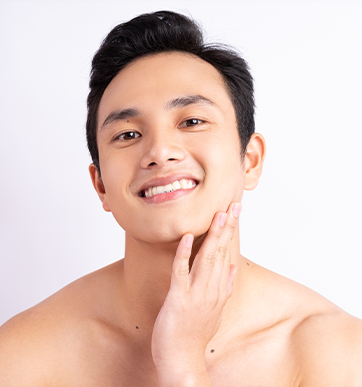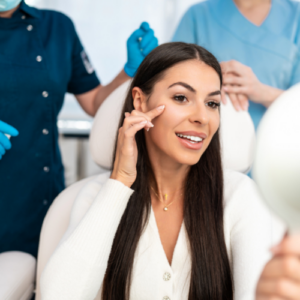
Ask the Dermatologist: Men’s Hair Loss & Skincare
Men and women can experience the same basic dermatological issues. However, there are certain challenges that men face more often or with far greater intensity. California Skin Institute’s Dr. Jennifer Sorrell, a triple board-certified dermatologist, gives advice on questions that men commonly have about hair loss and skincare.
Q: I’ve noticed acne appearing on my chest and back, especially when I’m more active or exercising a lot. What gives?
A: Acne can definitely be more active when you’re sweating more, whether due to exercise, warm weather or increased physical activity. If you have a delay between sweating and taking a shower, the sweat can promote clogged pores and bacteria, leading to flares.
I suggest using a cleansing wipe to clean the acne-prone areas as soon as you complete your activity. Keep this in your gym bag for easy accessibility. A benzoyl peroxide wash is another over-the-counter option for mild acne on the chest and back. Look for one containing between 3-5% benzoyl peroxide, and use it daily in the shower. I recommend California Skin Institute Creamy BP Wash. This active ingredient does bleach linens, so use a white washcloth and towel.
If your acne is deeper and more severe, see your board-certified dermatologist to customize an effective treatment plan for you.
Q: I like to keep my face clean-shaven, but I get lots of ingrown hairs and tiny bumps from shaving. How can I treat this?
A: This condition is called pseudofolliculitis barbae, and can be very frustrating. The hairs in the mustache and beard distribution tend to be coarser, with a higher likelihood of turning back in on themselves. This can lead to an ingrown hair that becomes inflamed. Complications can include a dark mark left behind after the inflammation has resolved, as well as keloid or thickened scarring.
I recommend washing once daily with an exfoliating glycolic-acid product, like California Skin Institute’s Glycolic Elite Cleanser, to help keep hair follicles unblocked. Also use a single-blade disposable razor or electric razor, and shave with the grain of the hair rather than against it. Using a moisturizing shaving cream can also help. Prescription-strength options include a topical retinoid like Retin-A to exfoliate the skin and a bleaching cream to lighten dark spots. If you like the idea of being clean shaven all the time, laser hair removal can be a great way to eliminate the source of the problem.
Q: I really enjoy spending time outdoors, and am having trouble finding a sunscreen that works for me. Any suggestions?
A: Outdoor adventures are amazing and fun for sport and relaxation. Being vigilant with sun protection is essential to help prevent skin cancer and premature aging. Ideally, a sunscreen will provide broad-spectrum protection against both UVA and UVB rays.
I recommend a sunscreen containing zinc oxide. This active ingredient helps physically block a broad spectrum of the sunlight, yet is gentle on sensitive skin. Ideally, go with a water-resistant lotion sunscreen for first application, like the CSI Sport Sunscreen 45 SPF. While a spray is convenient, it is important that you apply enough of the sunscreen and also rub it in. I recommend starting with a lotion sunscreen for your first application and reserving a non-aerosol spray for reapplications. Good zinc oxide-based sunscreens include California Skin Institute’s Sheer Physical Sunscreen and Essential Daily Wear SPF 50. No matter which sunscreen you choose, remember to reapply often throughout the day!
Q: I feel like my hair is thinning and I have less hair at the top of my scalp. What can I do?
A: This sounds like male pattern hair loss. It often begins with hair receding at the temples as well as thinning and falling out on the top (vertex) of the scalp. In some patients, it can start as early as adolescence.
A good first step is often to use minoxidil. This over-the-counter topical medication has been found to be helpful in preventing additional hair loss and, in some cases, regrowing hair. I recommend the 5% concentration, which comes in a solution and foam vehicle. When applied 1-2 times daily to the affected area, you should start to see results — after some possible initial shedding — in about 2-3 months. There are also some OTC shampoos that can be helpful for thinning hair.
If you’re experiencing more severe hair loss or desire aggressive treatment, consider the oral medicine called finasteride (Propecia). You’ll need an appointment for a prescription from your dermatologist, who will also discuss some important side effects with you. A newer treatment showing some promising results is called PRP. It involves injecting a concentrated sample of your own blood plasma into thinning areas to promote hair growth. PRP is typically performed monthly for four treatments, then switches to 2-3 times per year for maintenance. Your best plan of attack is to work with your board-certified dermatologist to come up with a custom-tailored treatment plan!
If you still have unanswered questions about your skin or hair — or need expert diagnosis and treatment — make an appointment to see Dr. Sorrell at California Skin Institute’s San Francisco or San Mateo office. Not convenient locations for you? Schedule a time to be seen by another board-certified dermatologist at any of our locations throughout California.



 / 291 Reviews
/ 291 Reviews